"Spring is the time of plans and projects" - Leo Tolstoy (Anna Karenina)
"In the spring, at the end of the day, you should smell like dirt" - Margaret Atwood (Blackbeard's Egg)
It's not for me to say if anybody smelt like dirt at the end of Saturday's 2022 LbF opener, A Rite of Spring:Roving Royal Parks, but if anybody did it was probably me. Masked, ever so slightly, by the aroma of ale and cheese dosa.
Let's, instead, consider the Tolstoy quote. Spring is indeed a time for plans and projects and back in 2020 I'd planned this very project. A walk that I'd hoped would see us walking through two of London's largest, and most enchanting, parks just as the flowers were coming into bloom and the trees in blossom.
As you are only too well aware, soon a virus scuppered those plans so I rearranged the walk for 2021. The virus still wasn't ready to let us go walking though. So one more postponement. In 2022, though the virus is still here we are - thanks to the vaccination programme - in a much better place and my main concern for the walk was would people turn up and would the weather hold out. A walk in the park in the rain on my own didn't sound like much fun.
Luckily, it was the sunniest and, at times, warmest day of the year - if surprisingly windy - and people did turn up. A nice number too. I took the train from Honor Oak Park to London Bridge, from there to Waterloo, and from Waterloo to Fulwell. Pam hopped on at Clapham Junction and when we alighted at Fulwell we saw that Mo had been on the same train too (jumping on at Wimbledon).
Past the first of many beautiful magnolias and cherry blossoms, we made our way to Pop In Sam's Cafe where we met with Dave Fog. I had some rather lovely scrambled egg on toast and Pam had a veggie breakfast she was so proud of she offered it up to my camera. Mo had a sausage sandwich. Everyone deemed their brunch to be most agreeable.
On leaving the cafe we met with, for the first time ever - but hopefully not the last, debutante LbF walkers Roxanne and Clive. It was a pleasure to have them on board although I didn't get to talk to them as much as I'd have liked to at the beginning as I was navigating the streets to get us to Bushy Park and then navigating, not initially successfully, Bushy Park itself.
Nobody seemed too bothered. The sun was out and Bushy Park was showing its best side even if the deer, at first, were proving elusive. At 1,100 acres Bushy Park is the second biggest of London's Royal Parks. More than twice the size of Regent's Park in third spot but less than half the size of Richmond Park which we'd come to later.
The area has been settled for at least four thousand years and there is evidence that in medieval times it was used for agricultural purposes. When Henry VIII took over nearby Hampton Court Palace from Cardinal Wolsey in 1529 he established the area as, of course, a deer hunting ground. It seems that when Henry VIII wasn't getting married, having his wife's heads chopped off, or gnawing on roasted meat at banquets he was out killing deer.
What he had against them we can only speculate. Bushy Park, on a sunny day in March, was mostly baked earth but there were still some muddy patches. The sun shone through the branches of the trees and the reflections on the various ponds was a delight to take in. The prettiest area, though, is the enclosed, no dogs off the lead, Woodland Gardens.
The daffodils were glorious and many and the clear water of the Longford river flowed quietly down gentle waterfalls and under small brick tunnels, meandering uncertainly and leisurely as if it appreciated that it was the weekend, as if it wanted to take in the sunshine as much as we did.
The Longford River (actually a canal that flows from the Colne near Heathrow Airport to the Thames) was built on the orders of Charles I (before he had his head chopped off) to provide water for Hampton Court and Bushy's various ponds. Later, William IV served as ranger for the park and during World War I it housed the King's Canadian hospital.
Between the wars the park hosted a camp for undernourished children and in World War II it is where Eisenhower planned the D-Day landings (there's a plaque somewhere but it's a big park). Nowadays it's home to Teddington rugby and hockey clubs (the rules of modern hockey were actually devised here) and four cricket clubs.
The Woodland Gardens are definitely my favourite part of the park but it wasn't until we left them into the wilder, and more open, park proper that we glimpsed our first group of deer. Quite a large group, forty or fifty, female deer relaxing in the sunshine. Nearby a smaller group of male deer, stags, did the same. It was an impressive display of antlers.
We followed a wide open green space to the Diana Fountain and, there, I delivered a few more of what Roxanne called 'factoids' (she's not wrong and I'll be nicking that term in the future). The Diana Fountain, and Chestnut Avenue - the wide park road that flanks it, were designed by Christopher Wren as a grand approach to Hampton Court Palace but were mainly being enjoyed today by us and a few solitary coots.
Diana was originally commissioned by Charles I for a garden in Somerset House. The initial design, by Inigo Jones, is believed to based on similar features in Bologna and Augsburg. During the Commonwealth era. Cromwell had the fountain relocated as such things, such vain follies, were not popular with his supporters. One of whom, a Mrs Nethaway, claimed "demolish these monsters that are set up as ornaments".
When William III and Mary II commissioned Wren to rebuild Hampton Court Palace he built Chestnut Avenue and took the Diana Fountain as its centrepiece. The age should tell you that it's not Diana Spencer, Princess/Lady Diana, that is commemorated on the fountain but some tend to believe it is. It's not even Diana, the Roman goddess of the hunt. In fact it's not even Diana at all but Arethusia, a nymph who fled from Arcadia to Syracuse in Sicily in Greek mythology.
We strolled past more deer towards the corner of the park and The King's Field with its rather unusual trainer tree and came out on the busy Hampton Court Road before crossing Kingston Bridge from Hampton Wick into Kingston. Where Pam was born.
The Grade II listed Kingston Bridge was, until Putney Bridge opened in 1729, the only Thames crossing between London Bridge and Staines. The 16c antiquarian John Leland had it that it existed, in some form, since before 1066 ("and yn the old tyme the commune saying ys that the bridge where the common passage was over the Tamsie was lower on the ryver then it is now") though others estimate it dates back to the 1190s.
Over the centuries there have been many Kingston Bridges (destroying bridges that span the Thames gave power) but the current specimen dates from 1828 was designed by Edward Lapidge (the son of Hampton Court's head gardener) and made of Portland Stone. We'd already done nearly five miles so we stopped for a drink. The Ram on the riverside looked as inviting as ever.
We weren't the only ones to think so. The outdoor area was full so we took a table inside (we'd get enough sunshine anyway) and I decided against a DOG ALE and, instead, Pam furnished me with a Twickenham Grandstand ale. I like to go local if possible.
It was a pleasant pit stop and while we were taking it Eamon WhatsApped us to let us know he'd reached Richmond. We'd meet him later but my tour of Kingston was not yet finished. By the banks of the Hogsmill river we could just make out the Coronation Stone, an ancient sarsen block that is believed to be the site of the coronation of seven Anglo-Saxon kings. Kingston, presumably, coming from town of kings or even stone of kings.
The kings in question include Aethelstan (925), Eadred (945), Aethelred the Unready (979) and, it seems historians are less sure about these four, Edward the Elder, Emund I, Eadwig, and Edward the Martyr. Behind the Coronation Stone stands Maurice Webb's glorious neo-Georgian guildhall (Grade II, built in 1935) and to cross the Hogsmill we took the Clattern Bridge.
The Clattern Bridge is said to be the oldest bridge still standing in London and one of the oldest in the country. It takes its name from the 'clattern' of horse's hooves as they walked over it. Until the 18c it was used for ducking colds with a cucking stool in the Hogsmill below and, less unpleasantly, as a goal for a local annual Shrove Tuesday football match. The much larger Kingston Bridge was the other goal which seems a bit unfair.
We headed through Kingston Town centre as Pam pointed out such sights at the Littlewoods she used to work in. It had that pleasant spring Saturday afternoon feeling that never changes much from town to town and from year to year. People shopping, sipping coffee, eating snacks. bumping into friends, and generally enjoying their weekends.
There's a mixture of modern/post-modern and Tudor/mock Tudor/even Art Deco architecture and if it's a bit of a mish-mash it is a typically British form of mish-mash and one that, through familiarity I guess, is rather comfortable. We passed through a few residential streets, though ones with inviting looking pubs and, excitingly for Pam, a bright pink lamp post, and soon reached the Kingston Gate of Richmond Park.
Eamon was waiting for us and Mo celebrated with an ice cream, a 99. Richmond Park, as mentioned earlier, is the biggest Royal Park in London and the second biggest urban walled park in the country behind Birmingham's Sutton Park (Sutton Coldfield). It was created in the 17c by Charles I as a place to, you guessed it, hunt deer.
Charles had, in 1625, brought his court to (the now gone) Richmond Palace to escape a London plague outbreak. The only bigger park in London is the Lee Valley Park (which also spreads out into Essex and Hertfordshire) and, thanks to John Lewis (not the shop but a local brewer) who secured public rights of access in 1758, we can all enjoy it now - and many do - and many were.
It was looking pretty good too. We walked to the central Pen Ponds (as we had on the Capital Ring back in 2020) and passed between them, enjoying the sun now low in the sky, more deer, and the general feel of such a vast open space that at times could easily fool you into thinking you are a long way from London.
That changes as the tower blocks of Roehampton, supposedly inspired by Le Corbusier, come into view. It's odd to have them in one direction and well over a hundred deer roaming freely in another. It's nice though - and very London. The Pen Ponds are two of roughly thirty ponds in Richmond Park and were once used to rear carp for food.
From many of these ponds small streams, 'meander scars', and even rivers flow. We followed, roughly, very roughly, the course of the Beverly Brook (which flows fourteen miles from Worcester Park to the Thames at Putney and is believed to get its name from the former presence in its water of the European beaver, a species extinct in Britain since the 16c though recently reintroduced to Scotland) to the edge of the park where I, following Mo's example, treated myself to a 99 and pondered why they are called 99s.
There's a lot of different theories and this wasn't a 'history of ice cream' walk so let's get back to talking about Richmond Park. There's far too much history to go into it all but here's a few factoids:- Garibaldi visited Lord John Russell at Pembroke Lodge (in 1864) as did the Shah of Persia and, in 1873, Naser al-Din Shah Qajar, the first Iranian monarch to visit Europe.
In World War II it was used for cavalry training and the large ponds were drained out and converted into homes for anti-aircraft missile launchers. In 1948 it hosted an Olympic Village and in 1953 Tito visited the White Lodge. Eisenhower popped over from his HQ is Bushy Park to take a look too.
The wall around Richmond Park is 9ft high and eight miles long and the gates were designed by Sir John Soane. There's a neolithic burial mound (King Henry's Mound), a Thames Valley panorama, a musical bench in tribute to Ian Dury and the park is home to 630 red and fallow deer. Two hundred of whom are culled annually and sold off as meat.
Other wildlife in the park, much of which we didn't see, includes parakeets, squirrels, rabbits, frogs, toads, stag beetles, woodpeckers, and snakes. The park has been painted by such notables as Joshua Reynolds, Thomas Rowlandson, John Martin, and Spencer Gore and has featured in films like Billy Elliot, Performance, and The Titfield Thunderbolt.
After the ice cream and the brief history lesson we left the park and walked along the long straight Priory Lane towards Barnes. Priory Lane is flanked by some rather nice, and expensive looking houses, and the LTA National Tennis Centre but is most famous for The Priory. The former convalescent home, if briefly, of an incredibly long list of names.
Those who have stayed, some with more success than others, in The Priory include, and this is from the Wikipedia page so it's all already out there, George Best, Marti Pellow, Pete Doherty, Graham Coxon, Sinead O'Connor, Lily Allen, Susan Boyle, Justin Hawkins of The Darkness, Richey Edwards, Katie Price, Jade Goody, Paula Yates, Amy Winehouse, Robbie Williams, Kate Moss, Michael Elphick, Ronnie O'Sullivan, Gazza, Antonio Carluccio, and Johnny Depp.
I didn't expect Elphick to be the only one in that list I could hyperlink to but if it was thirsty work reading them not to worry, there's a pub quite near The Priory! Leaving aside its current use it's architecturally quite unlikely. Originally built as a private home in 1811 in the Gothic Revival/Strawberry Hill Gothic style (think Strawberry Hill House itself, the Tom Tower in Oxford, the cathedrals of Cologne and Liverpool, the Victoria Terminus in Mumbai, or the Hungarian Parliament Building or, closer to home, Tower Bridge or St Pancras) it's kept the same outside look and even though a former friend of mine once stayed there he never had the decency to tell me what it looks like from the inside.
To be fair he wasn't the most reliable of witnesses so perhaps nothing lost there. We crossed the A205 South Circular and through a piece of common land and Barnes station and just before you go over a railway bridge on to Barnes Common proper you, and you need to look around, find yourself, as we had planned, at the site of the Marc Bolan rock shrine.
Bolan died here, aged 29, died here on 16th September 1977 when a Mini (driven by his girlfriend Gloria Jones) he was in crashed into a sycamore tree after failing to negotiate a humpback section. To die in a Mini seems a cruel irony for the man who once sang that he drove a Rolls Royce because it was good for his voice.
Even though he couldn't actually drive. It's remarkable how many amazing songs he wrote before he even turned thirty. Cosmic Dancer, Hot Love, 20th Century Boy, Life's A Gas, Jeepster, Metal Guru, Children of the Revolution. The shrine is clearly regularly visited by Bolan fans (one from as far away as Bulawayo in Zimbabwe) and it is as irreverent as it should be while at the same time managing to be respectful. I liked the fact that were memorials to people he worked with in T Rex and elsewhere. People like Steve Peregrine Took and Mickey Finn.
I also liked the white swan - even if it was too small to even begin to ride on. People were sat enjoying the late afternoon sunshine on Barnes Common but after stopping briefly to admire the below fingerposts we headed into The Spencer pub. A pleasant enough place but very noisy. Not just the rugby but a screaming kid at the next table.
Roxanne and Clive said goodbye and vowed to return one day and I had a delightful pint of Sambrook's Junction as we decided if we'd carry on to Hammersmith or call it quits there. It had been a long day.
The responses were mixed but we settled on a good compromise. Mo would take the bus up to Hammersmith and me, Pam, Dave F, and Eamon would walk up and meet her there. Once we'd passed the bizarrely named Chaps off license and got to Putney, the Half Moon pub telling me we were in danger of going the wrong way, it was basically a repeat, at almost the exact same time, of the final stretch of last week's Thames Path walk.
Craven Cottage, the broad sweep of the river, the old Harrods Furniture Depository, under and then over Hammersmith Bridge, the flyover, a pint in the Swan, and back to Sagar (for me, the third time in eight days, I'd also visited before seeing Ava at the Riverside Studios on Wednesday and the staff there certainly recognised me).
This time I had cheese dosa (again, predictably) and dal and, of course, a Cobra or two. We discussed the war in Ukraine, the Troggs, and our work lives and Pam showed me on her watch that she'd notched up over 40,000 steps. A number that, I believe, Mo equalled by the time she got home. I hit a 2022 record of 33,846 steps and I was pleased with that as we took various tubes back home where I reflected on a day that had been, for me and I hope for others, thoroughly enjoyable.
The weather had (mostly) held, the people had arrived, and, when that happens, London tends not to disappoint. On Saturday it didn't. The plans and projects Margaret Atwood wrote about, it seems, do happen after all. Just need a bit of patience.
Thanks to Pam for the snaps and Mo for the maps I've used here and thanks to both of them, and Dave F, Eamon, Roxanne, and Clive for making this walk, finally - after over two years, and day such a pleasurable one. LbF go again, out in Thamesmead, Abbey Wood, and Woolwich next month.


















































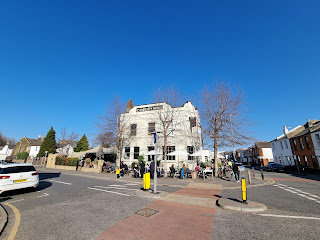




















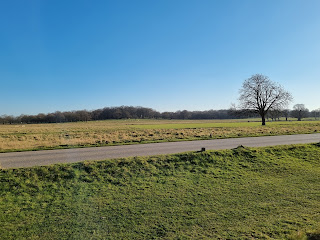










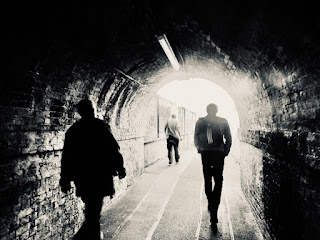


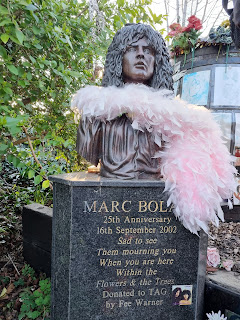










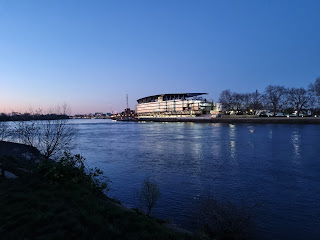







No comments:
Post a Comment